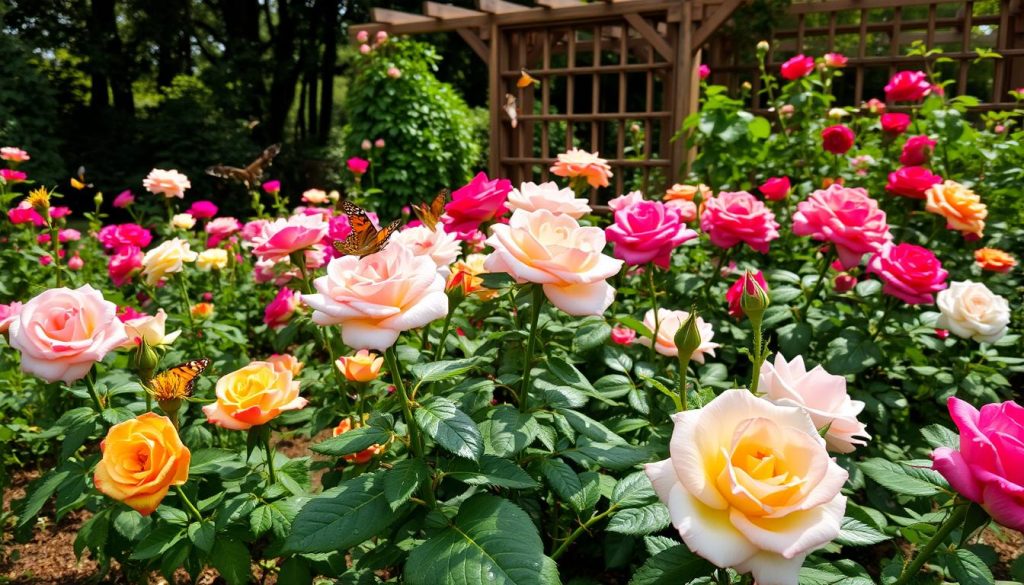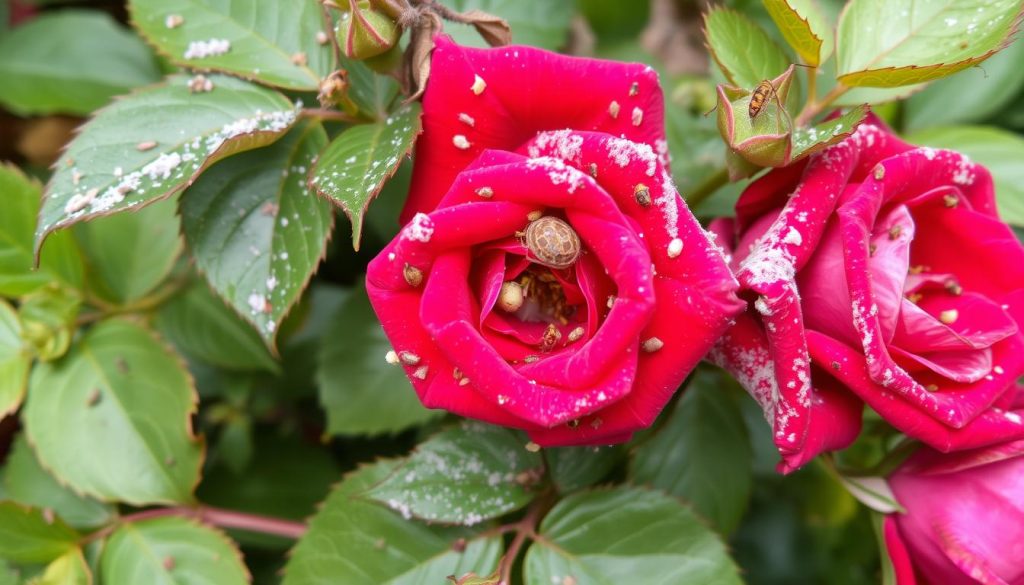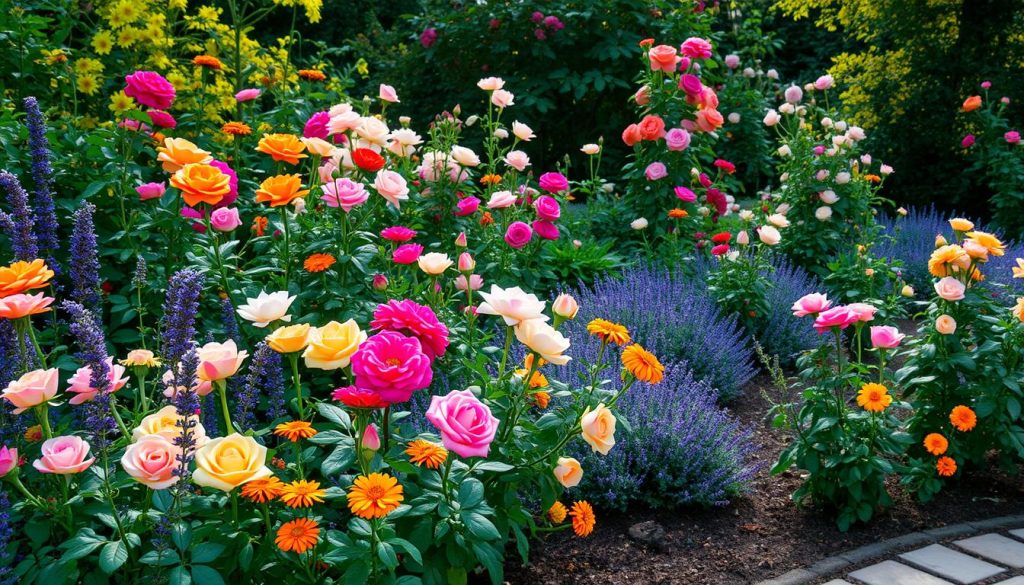Rose gardening is a rewarding hobby for all gardeners. It’s easy to make your rose plants bloom beautifully. This guide will teach you how to pick the best spot, prepare the soil, water, and prune your roses.
Rose gardening adds beauty and joy to any outdoor space. It’s great for both experienced gardeners and beginners. This guide will help you grow healthy, vibrant roses. You’ll learn about choosing the right varieties and seasonal care.

Key Takeaways
- Roses thrive in well-drained, nutrient-rich soil and require at least 6 hours of direct sunlight per day.
- Pruning roses in early spring helps promote healthy growth and reduce the risk of fungal diseases.
- Choosing disease-resistant rose varieties can simplify care and prevent common issues like powdery mildew and black spot.
- Proper watering techniques, such as deep irrigation and avoiding overhead watering, are crucial for strong, vibrant roses.
- Fertilizing roses with a balanced, high-phosphorus formula can encourage larger, more abundant blooms.
Understanding the Basics of Rose Growing
Roses are a favorite in gardens, loved for their beautiful flowers and sweet smell. They have a long history as symbols of love and beauty. Exploring rose varieties, care, and growing tips opens up a world of possibilities for gardeners.
Types of Rose Plants Available
The rose family, known as Rosa, has many different types. You can find tiny micro-miniatures and big grandifloras, as well as climbing roses that cascade. There are also shrub roses, like the Oso Easy line, that are easy to care for and grow well in many places.
Benefits of Growing Roses
Roses are not just pretty and fragrant; they also connect us to our past and culture. Some roses are even good to eat, adding a fun twist to gardening. Growing roses lets gardeners create lasting memories and celebrate the beauty of this iconic flower.
Common Rose Growing Myths Debunked
Roses are not as hard to grow as people think. Many believe they need a lot of care or can’t grow in certain places. But with the right knowledge, anyone can have a beautiful rose garden.
Selecting the Perfect Location for Your Roses
Choosing the right spot for your rose garden is crucial. Roses love sunlight, needing 6-8 hours a day. They also need well-drained, rich soil to grow well.
In hot areas, keep roses out of the strong afternoon sun. Planting them near walls or fences can offer shade. This helps prevent sun damage. In cold places, put roses near south or west walls for winter protection.
Don’t forget about spacing. Plant roses at least 3 feet apart. This lets them grow and keeps air moving. It also stops diseases from spreading.
- Roses require 6-8 hours of daily sunlight for optimal growth and flowering.
- Well-drained, organic-rich soil is essential for rose success.
- In hot climates, protect roses from intense afternoon sun by planting near structures.
- In cold regions, situate roses near south or west-facing structures for winter protection.
- Proper spacing (at least 3 feet apart) allows for mature growth and air circulation.
By thinking about these factors, you can make a great spot for your roses. They’ll bloom beautifully in your garden.
Soil Preparation and Planting Techniques
Preparing the soil is key to a thriving rose garden. To create the perfect spot for your roses, focus on the soil’s makeup. Make sure the planting depth and spacing are just right.
Ideal Soil Composition
Roses love slightly acidic to neutral soil, with a pH of 6.0 to 7.0. Mix in compost or peat moss to boost soil quality. The best mix is one-third clay, one-third coarse sand, and one-third organic matter.
Adding blood and bone or Epsom salts can help too. They give roses the nutrients they need for strong roots and health. But, make sure the soil drains well, as roses don’t like wet feet.
Proper Planting Depth and Spacing
Planting depth depends on your climate. In mild areas, plant at ground level. In colder places, bury the canes 2-3 inches deep to protect them in winter. Plant them 3 feet apart for good air and growth space.
Apply a slow-release fertilizer when planting and water well to help them settle. Mound soil around the canes for extra protection during the first few months.
Best Time for Planting
The best time to plant roses is in spring, after the last frost, or early fall, 6 weeks before the first frost. This lets the roots grow strong before harsh weather hits.
With the right soil prep and planting, you’re on your way to a successful rose care journey. Your garden will soon be filled with beautiful, healthy blooms.
Essential Watering Guidelines
Keeping the soil moist is key for healthy rose plants. The amount of water needed varies based on soil type, climate, and weather. Aim for about 1 inch of water per week, from rain or irrigation.
Sandy soils drain quickly, so they need more water, often every two to three days in hot weather. Clay soils hold moisture longer and may only need watering every four to five days. Adding organic matter to the soil can help with drainage and moisture retention.
- In temperatures over 90 degrees Fahrenheit, roses should be watered daily.
- Roses should be watered every two days at 80 degrees Fahrenheit, every three days at 70 degrees Fahrenheit, every four days at 60 degrees Fahrenheit, and every five days at 50 degrees Fahrenheit.
- Container roses usually need daily watering during extremely hot weather.
To keep plants hydrated, soak the soil 16 to 18 inches deep. Avoid getting the leaves wet to prevent fungal diseases. Use drip irrigation, underground sprinklers, or hand-watering for efficient watering. A 2- to 4-inch layer of organic mulch can also help keep the soil moist and reduce evaporation.
It’s important to check the soil moisture regularly and adjust watering as needed. Well-watered roses are less likely to get pests and diseases. They will also give you plenty of beautiful flowers.
Rose Gardening Fundamentals for Beginners
Starting a rose garden can seem hard for new gardeners. But, with the right steps, it can be a fun and rewarding hobby. Growing container roses is a great way to begin your rose gardening journey.
Starting with Container Roses
Container roses are perfect for beginners. They are easy to plant and grow fast. These small roses do well in pots and are great for small spaces or balconies.
Choose disease-resistant varieties like Knock Out Roses or Drift Roses. They need little care and bloom all season long.
Basic Care Requirements
- Provide at least 6 hours of direct sunlight per day for optimal growth.
- Water your roses when the top 1-2 inches of soil are dry, ensuring deep watering for healthy roots.
- Fertilize your roses regularly to maintain lush foliage and abundant blooms.
- Mulch around the base of your roses with a 4-inch layer to regulate soil temperature and suppress weeds.
Common Mistakes to Avoid
- Overwatering: Roses are susceptible to fungal diseases if the soil stays too moist.
- Improper pruning: Cutting roses incorrectly can stunt their growth and reduce flowering.
- Neglecting pest management: Monitor your roses for common pests like aphids and Japanese beetles, and address them promptly using organic control methods.
By following these basic tips, you can grow a beautiful rose garden even if you’re new. Remember, patience and a little care can make your roses bloom beautifully.
Fertilizing for Optimal Bloom Production
Proper fertilization is key for rose gardeners wanting stunning blooms. Roses need a steady supply of nutrients to grow well and bloom. Knowing what nutrients are important and when to feed them can make your rose garden bloom beautifully.
Nitrogen, phosphorus, and potassium are essential for rose growth. Use a balanced fertilizer like alfalfa meal for new plants to help them grow leaves. As plants get older, use slow-release fertilizers and organic options like compost to keep them nourished.
- Epsom salts help with leaf and cane growth. Use 1/4 to 1/2 cup at the base of the plant.
- Fertilize new roses every 3 to 4 weeks with fish emulsion.
- For older roses, use high-nitrogen fertilizers for leaves and slow-release for growth.
- Bone meal is good for late summer to help with root growth and next year’s blooms.
Container roses need more fertilizer because of the quick water draining. Organic fertilizers like compost and bone meal are good for the soil and plants. Synthetic fertilizers are cheaper but don’t improve the soil.
It’s important to keep the soil pH between 6.0-7.0 for best nutrient absorption. Fertilize before and after watering to help the plants absorb nutrients well. Avoid fertilizing in very hot weather to prevent stress.
With a good fertilization plan, your roses will bloom beautifully. A little extra care can make your rose garden the highlight of your outdoor space.
Pruning Techniques for Healthy Growth
Rose pruning is key for a plant’s health and beauty. The right pruning can lead to lush, vibrant rose bushes. Let’s look at the seasonal pruning guide and the tools you’ll need.
Seasonal Pruning Guide
The best time to prune roses depends on your area. Here’s a general guide:
- Zones 3 and 4: Prune in May
- Zones 5, 6, and 7: Prune in March or April
- Zone 8: Prune in February or March
- Zone 9: Prune in January or February
- Zone 10: Prune in January
Do major pruning in early spring, after the last frost. This encourages growth and blooms. In the growing season, remove spent flowers to encourage more blooms in some varieties.
Tools and Equipment
Having the right tools is crucial for pruning. You’ll need sharp bypass pruners, loppers for big canes, and rose pruning gloves. When you prune, cut just above an outward-facing bud eye. This helps the plant grow in the right direction.
Using the right tools and techniques will keep your rose garden healthy and beautiful for years.
Disease Prevention and Management
To keep your rose garden healthy and thriving, you need to watch out for diseases. Knowing the common threats and taking action early can help. This way, you can enjoy your roses for a long time.
Choosing disease-resistant roses is a smart move. Roses like ‘Alba Semi-Plena’ and ‘Blanc Double de Coubert’ fight off black spot and powdery mildew well. These are two big problems for roses.
Powdery mildew looks like a grayish-white dust on leaves and buds. To fight it, water in the morning and prune to let air move better. Black spot causes black spots on leaves. To stop it, remove infected leaves fast and use a baking soda and oil mix or an organic fungicide.
- Maintain good air circulation around plants to discourage disease spread.
- Water at ground level to keep foliage dry and prevent disease development.
- Regularly remove and dispose of fallen leaves and other plant debris to eliminate sources of infection.
By taking these steps and acting fast when diseases appear, you can keep your roses looking great for years.
Natural Pest Control Methods
As a rose lover, fighting pests and diseases can be tough. But, there are natural ways to keep your garden healthy. Let’s look at common pests and how to fight them with organic methods.
Common Rose Pests
- Aphids: These tiny bugs suck sap from roses. A morning water spray can wash them off.
- Spider Mites: These pests spin webs and damage leaves. Neem oil or soap can help.
- Sawflies: Their larvae eat rose leaves. Soap or neem oil can control them.
- Japanese Beetles: They eat rose leaves and flowers. Hand-picking or a botanical spray can help.
Organic Solutions
To keep your roses healthy without harsh chemicals, try these natural methods:
- Companion Planting: Plant garlic, onions, and chives to repel pests.
- Encourage Beneficial Insects: Offer nectar and pollen to attract natural predators.
- Homemade Sprays: Mix water, vinegar, baking soda, and soap for a pest spray.
- Organic Oils: Use neem oil and soaps to kill pests like aphids and spider mites.
Keep an eye on your roses and act fast if you see pests. With natural deterrents and organic treatments, your garden can stay healthy and beautiful.

Seasonal Care and Maintenance
Caring for your rose garden needs a seasonal approach. This ensures your plants thrive and bloom beautifully. As a dedicated rose enthusiast, I’ve learned that a consistent routine is essential for healthy roses.
In spring, it’s time to prune and fertilize your roses. I use Maxsea Rose & Flower Food every 1-2 weeks. This promotes growth and more flowers.
- Prune roses in late winter or early spring, cutting back to the first leaf with five leaflets.
- Feed roses with a rose-specific fertilizer every 1-2 weeks during the growing season.
- Monitor for pests and diseases, and treat with a neem-based insecticide/fungicide as needed.
Summer care includes watering, deadheading, and pest management. I water my roses deeply once a week. Deadheading spent blooms encourages more flowers. Weekly spraying with a neem-based product keeps pests and diseases away.
As fall comes, I reduce fertilization and prepare my roses for winter. Proper winter protection is key, especially in cold climates. Cleaning up fallen leaves and debris prevents disease spread.
Year-round care is crucial for a thriving rose garden. By following these seasonal guidelines, you can enjoy beautiful rose blooms from spring to fall. Your plants will also be ready for winter.
Creating Beautiful Rose Arrangements
Making rose arrangements is like painting with flowers. It lets you show off the beauty of these gorgeous blooms. You can decorate your home or make a special gift. Learning how to cut, preserve, and keep roses fresh in a vase is crucial.
Cutting and Preserving Tips
For the longest-lasting arrangements, cut roses when the buds start to open. Cut them in the morning or evening when the plants are full of water. Use sharp, clean tools and cut at a 45-degree angle for a clean stem. Then, put the roses in water right away to stop them from wilting.
Vase Life Extension Methods
- Use warm water and a floral preservative solution in your vase. You can make your own by mixing lemon juice, sugar, bleach, and water.
- Recut the stems and change the water every few days to keep your rose arrangements fresh.
- Soak your vase in a 1:10 ratio of bleach to water for 2-4 hours. This kills harmful bacteria and keeps the water clean.
Follow these easy tips to enjoy your rose arrangements for longer. Try different styles and add contrasting flowers for stunning displays. Share your work by tagging @easyeleganceroses on social media.
Companion Planting with Roses
Make your rose garden more beautiful and healthy with companion planting. Choose plants that grow well with your roses. This way, you create a stunning and helpful garden ecosystem.
Try adding alliums like chives or garlic to keep aphids away. Roses paired with flowers like lavender or catmint attract beneficial insects. This helps your garden grow strong and balanced.
- Roses fit well in vegetable gardens or mixed borders if the plants need similar sun, water, and soil.
- Marigolds, sage, or yarrow are great companions for roses because they love full sun.
- Plant taller shrub roses at the back and shorter ones at the front. This adds depth and balance.
Plan your rose garden carefully to make it vibrant and healthy. It will show off the beauty of roses and their friends.

Winter Protection Strategies
As winter comes, gardeners in cold areas must protect their rose bushes. In USDA Zones 3, 4, 5, and parts of Zone 6, the cold is extreme. Special care is needed to keep roses healthy and alive.
Winterizing Methods
Start by giving roses a weekly “potassium feast” six weeks before the first freeze. This gets them ready for sleep. Also, use wood chip mulch all year, adding more in fall to keep roots warm and moist.
In late fall, pile compost and coffee grounds around the plants. This extra layer helps fight the cold. When the blooming stops, tie up canes and cut them back to 12-18 inches. This makes them stronger against winter.
Another good trick is to cover roses with plastic leaf bags when the ground freezes. This creates a shield against the weather.
Cold Climate Considerations
In very cold areas, gardeners need to be extra careful. Burying climbing rose canes in a trench and covering them with mulch works well. The author’s ‘Autumn Sunset’ climbing rose shows this.
For new plants, like the ‘Alnwick Rose,’ use rose collars filled with shredded leaves. This protects the roots from freeze-thaw damage.